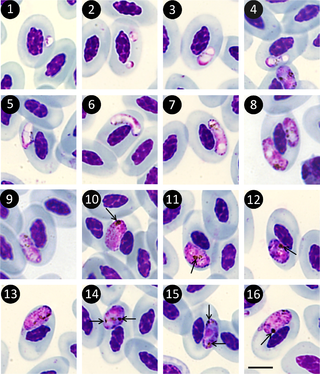
Plasmodium is a genus of unicellular eukaryotes that are obligate parasites of vertebrates and insects. The life cycles of Plasmodium species involve development in a blood-feeding insect host which then injects parasites into a vertebrate host during a blood meal. Parasites grow within a vertebrate body tissue before entering the bloodstream to infect red blood cells. The ensuing destruction of host red blood cells can result in malaria. During this infection, some parasites are picked up by a blood-feeding insect, continuing the life cycle.

Digenea is a class of trematodes in the Platyhelminthes phylum, consisting of parasitic flatworms with a syncytial tegument and, usually, two suckers, one ventral and one oral. Adults commonly live within the digestive tract, but occur throughout the organ systems of all classes of vertebrates. Once thought to be related to the Monogenea, it is now recognised that they are closest to the Aspidogastrea and that the Monogenea are more closely allied with the Cestoda. Around 6,000 species have been described to date.

The Plasmodiidae are a family of apicomplexan parasites, including the type genus Plasmodium, which is responsible for malaria. This family was erected in 1903 by Mesnil and is one of the four families in the order Haemospororida.
Galactosomum is a genus of flukes in the family Heterophyidae. There are currently 28 recognised species within the genus. They mainly infect aquatic birds, but often infest fish as larvae. Three species are known to use marine mammals as hosts.
Plasmodium anasum is a species of the genus Plasmodium subgenus Giovannolaia.
Hepatocystis vassali is a species of parasitic protozoa that infect mammals.
Hepatocystis pteropi is a species of parasitic protozoa. The vertebrate hosts are mammals.
Plasmodium hegneri is a parasite of the genus Plasmodium subgenus Papernaia.
Megaloschizonts are large schizonts that produce extremely high numbers of merozoites. They are found in various species of the Phylum Apicomplexa. The Apicomplexa phylum contains several parasitic protozoans. They have a very complex life cycle that includes several stages. Megaloschizonts and the smaller schizonts are the part of the life cycle that takes place inside the infected host organism and operates as an asexually reproductive cell. Megaloschizonts appear as grey-white nodules found in the smooth muscle of major organs, such as the heart, liver, lung or spleen.

The moustached guenon or moustached monkey is a species of primate in the family Cercopithecidae. It is found in Angola, Cameroon, Central African Republic, Republic of the Congo, Democratic Republic of the Congo, Equatorial Guinea, and Gabon.

The Haemosporida are an order of intraerythrocytic parasitic alveolates.
Plagiorhynchidae is a family of parasitic Acanthocephalan worms.
Hepatocystis is a genus of parasites transmitted by midges of the genus Culicoides. Hosts include Old World primates, bats, hippopotamus and squirrels. This genus is not found in the New World. The genus was erected by Levaditi and Schoen, 1932, as Hepatocystes.
Dactylosoma is a genus of parasitic alveolates of the phylum Apicomplexa.
Hepatocystis carpenteri is a species of parasitic protozoa. They are transmitted by flies of the genus Culicoides and infect mammals.
Hepatocystis brosseti is a species of parasitic protozoa that infect mammals. They are transmitted by flies of the genus Culicoides
Hepatocystis muuli is a species of parasitic protozoa. They are transmitted by flies of the genus Culicoides and infect mammals.
Hepatocystis perronae is a species of parasitic protozoa. They are transmitted by flies of the genus Culicoides and infect mammals.
Hepatocystis epomophori is a species of parasitic protozoa. They are transmitted by flies of the genus Culicoides and infect mammals.
Hepatocystis taiwanensis is a species of parasitic protozoa. They are transmitted by flies of the genus Culicoides and infect monkeys.




